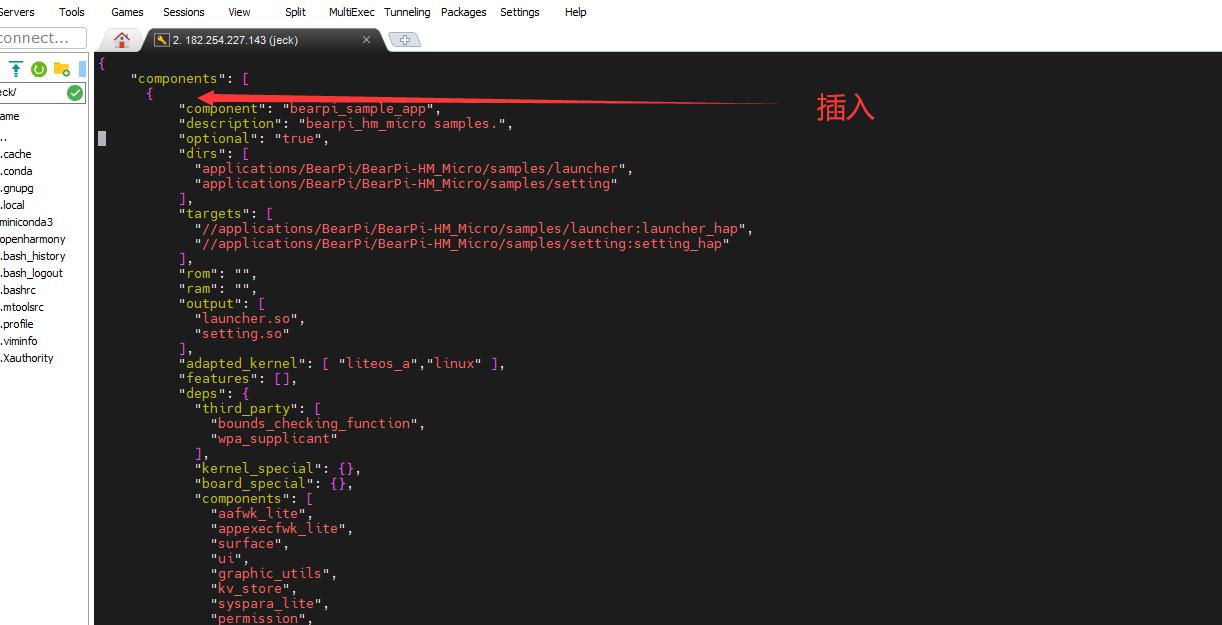OpenHarmony测试代码编译执行流程
Posted 嵌入式up笔记
tags:
篇首语:本文由小常识网(cha138.com)小编为大家整理,主要介绍了OpenHarmony测试代码编译执行流程相关的知识,希望对你有一定的参考价值。
文章目录
【OpenHarmony】测试代码编译执行流程
之前的文章我们搭建了小熊派的开发环境,并且拉取了源码到本地编译后烧写到了小熊派中,这一章将在上一章的基础上,编写一个用户态的执行程序,按照 OpenHarmony 的编译框架编译程序,然后在串口命令行执行程序
一、编译目录结构
首先先看一下要修改添加的文件架构
./applications/BearPi/BearPi-HM_Micro/samples
├── helloworld
├── BUILD.gn
├── include
│ └── helloworld.h
└── src
└── helloworld.c
./build
├── lite
├── components
└──applications.json
./vendor
└── bearpi
└── bearpi_hm_micro
└── config.json
一个用户态的业务代码设计到的文件框架基本如上面所示,下面进入代码编写
二、编写测试代码
首先编译业务测试代码,业务代码目录如下:
./applications/BearPi/BearPi-HM_Micro/samples
├── helloworld
├── BUILD.gn
├── include
│ └── helloworld.h
└── src
└── helloworld.c
include 用于存放头文件,src 则存放源文件,BUILD.gn 则是编译组织文件,用于编译当前目录下面的工程文件
首先编写 .h 文件,声明一个函数 HelloPrint,同时声明编译器使用 c 编译
#ifndef HELLOWORLD_H
#define HELLOWORLD_H
#ifdef __cplusplus
#if __cplusplus
extern "C"
#endif
#endif
void HelloPrint();
#ifdef __cplusplus
#if __cplusplus
#endif
#endif
#endif
再编写 .c 源文件,编写函数内容,显示 helloworld
#include <stdio.h>
#include "helloworld.h"
int main(int argc, char **argv)
HelloPrint();
return 0;
void HelloPrint()
printf("\\n************************************************\\n");
printf("\\n\\t\\tHello World!\\n");
printf("\\n************************************************\\n");
printf("OpenHarmony Code Test! JeckXu - Top嵌入式");
三、编写构建脚本
然后编写编译脚本文件 BUILD.gn
先导入编译组件,源码hello_world.c 编译成 hello_world_lib 模块文件:
# 导入编译组件
import("//build/lite/config/component/lite_component.gni")
然后编写可执行模块的详细信息,
# 可执行模块
executable("hello_world_lib")
output_name = "helloworld"
sources = [ "src/helloworld.c" ]
include_dirs = ["include"]
defines = []
cflags_c = []
ldflags = []
最后由模块编译生成的 lib 模块生成 my_app 组件:
lite_component("my_app")
features = [
":hello_world_lib",
]
四、添加组件
编译脚本将编译生成的文件和组件关联,下面我们进入到
./build
├── lite
├── components
└──applications.json
进一步修改组件信息,在如下位置插入新的组件信息:

新组件信息如下:
"component": "helloworld_app",
"description": "helloworld samples",
"optional": "true",
"dirs": [
"applications/BearPi/BearPi-HM_Micro/samples/helloworld"
],
"targets": [
"//applications/BearPi/BearPi-HM_Micro/samples/helloworld:my_app"
],
"rom": "",
"ram": "",
"output": [],
"adapted_kernel": [ "liteos_a" ],
"features": [],
"deps":
"components": [],
"third_party": [ ]
,
不同组件主要就是依赖和名称不同
五、修改开发板配置文件
最后就是修改开发板的配置文件,添加对应的hello部件:
./vendor
└── bearpi
└── bearpi_hm_micro
└── config.json
在应用子系统下添加组件

组件代码如下:
"component": "helloworld_app", "features":[] ,
添加完如下:
"subsystem": "applications",
"components": [
"component": "helloworld_app", "features":[] ,
"component": "bearpi_sample_app", "features":[] ,
"component": "bearpi_screensaver_app", "features":[] ,
"component": "bearpi_sample_communication", "features":[]
]
六、运行结果
到此一个应用程序组件添加完成,下面就是编译烧录,可以参考我之前的文章
编译指令
hb build -t notest --tee -f
这里我在腾讯云服务器上编译的,编译完成如下

拷贝结果文件,然后下载程序,下载后启动系统,在串口命令行执行业务代码:
./bin/hello_world
执行结果如下,执行成功

总结一下用户代码的编译流程,编写 BUILD.gn 编译代码生成执行文件,然后根据执行文件生成对应模块,编写组件关联调用模块
以上是关于OpenHarmony测试代码编译执行流程的主要内容,如果未能解决你的问题,请参考以下文章